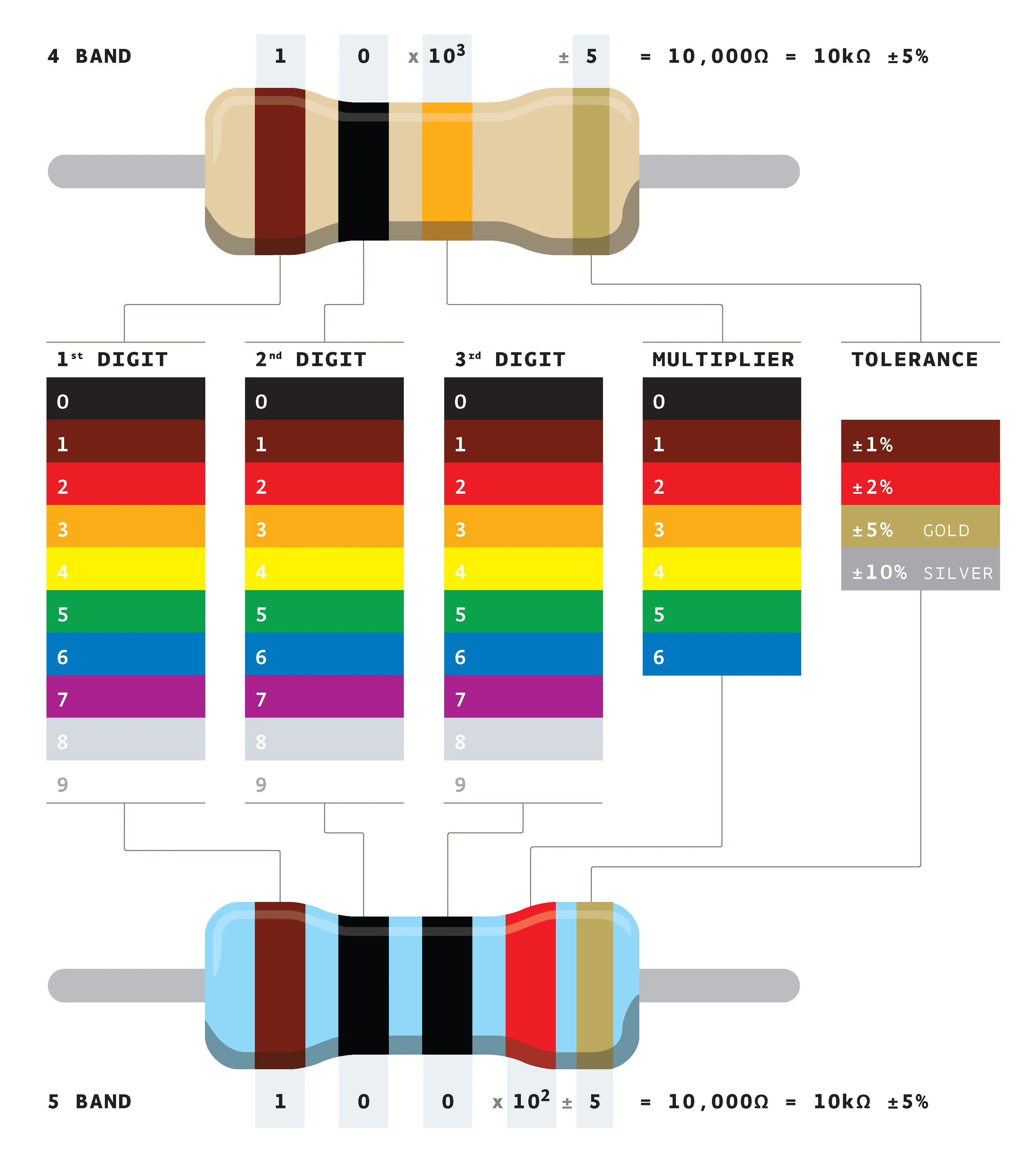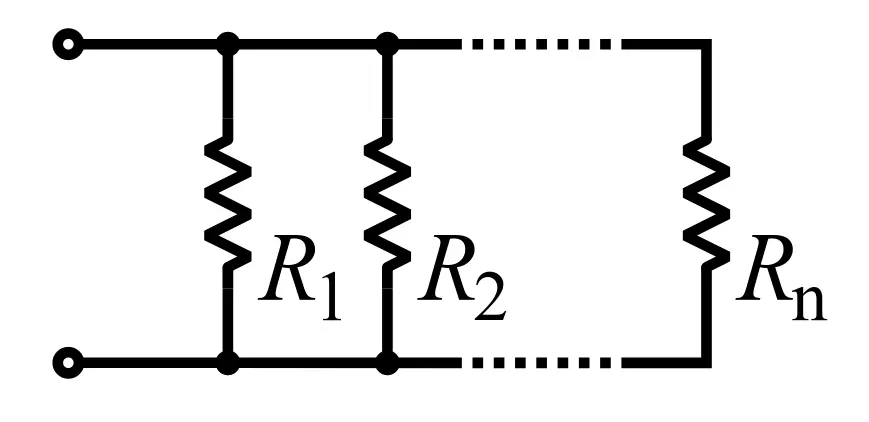Resistors, Transistors, and More

WHAT IS A RESISTOR ?#
A resistor is a passive two-terminal electrical component that implements electrical resistance as a circuit element. Put simply, a resistor is a thing that reduces current flow. It does this by converting the electric current into heat.
Within electronic circuits, resistors are used to reduce current flow, adjust signal levels, to divide voltages, bias active elements, and terminate transmission lines, among other uses.
High-power resistors that can dissipate many watts of electrical power as heat, may be used as part of motor controls, in power distribution systems, or as test loads for generators.
Fixed resistors have resistances that only change slightly with temperature, time or operating voltage.
Variable resistors can be used to adjust circuit elements (such as a volume control or a lamp dimmer), or as sensing devices for heat, light, humidity, force, or chemical activity.
Resistors are common elements of electrical networks and electronic circuits and are ubiquitous in electronic equipment. Practical resistors as discrete components can be composed of various compounds and forms. Resistors are also implemented within integrated circuits.
The electrical function of a resistor is specified by its resistance: common commercial resistors are manufactured over a range of more than nine orders of magnitude. The nominal value of the resistance falls within the manufacturing tolerance, indicated on the component.
HOW TO READ THEM#
The bands are from left to right A,B,C & D
To distinguish left from right there is a gap between the C and D bands.
- A) The first significant figure of component value (left side)
- B) The second significant figure (some precision resistors have a third significant figure, and thus five bands).
- C) The decimal multiplier (number of trailing zeroes)
- D) If present, indicates tolerance of value in percent (no band means 20%)
In the above example, a resistor with bands of red, violet, green, and brown has first digit 2 (red; see table below), second digit 7 (violet), followed by 5 (green) zeroes: 2700000 ohms. Gold signifies that the tolerance is ±5%.
Resistors manufactured for military use may also include a fifth band which indicates component failure rate (reliability); refer to MIL-HDBK-199[4] for further details.
All coded components have at least two value bands and a multiplier; other bands are optional.
 Adim kassn / CC BY-SA
Adim kassn / CC BY-SA
RESISTOR E-SERIES SCHEMES#
Early resistors were made in more or less arbitrary round numbers; a series might have 100, 125, 150, 200, 300, etc. Resistors as manufactured are subject to a certain percentage tolerance, and it makes sense to manufacture values that correlate with the tolerance, so that the actual value of a resistor overlaps slightly with its neighbours. Wider spacing leaves gaps; narrower spacing increases manufacturing and inventory costs to provide resistors that are more or less interchangeable.
A logical scheme is to produce resistors in a range of values which increase in a geometric progression, so that each value is greater than its predecessor by a fixed multiplier or percentage, chosen to match the tolerance of the range. For example, for a tolerance of ±20% it makes sense to have each resistor about 1.5 times its predecessor, covering a decade in 6 values. In practice the factor used is 1.4678, giving values of 1.47, 2.15, 3.16, 4.64, 6.81, 10 for the 1–10-decade (a decade is a range increasing by a factor of 10; 0.1–1 and 10–100 are other examples); these are rounded in practice to 1.5, 2.2, 3.3, 4.7, 6.8, 10; followed, by 15, 22, 33, … and preceded by … 0.47, 0.68, 1. This scheme has been adopted as the E48 series of the IEC 60063 preferred number values. There are also E12, E24, E48, E96 and E192 series for components of progressively finer resolution, with 12, 24, 96, and 192 different values within each decade. The actual values used are in the IEC 60063 lists of preferred numbers.
A resistor of 100 ohms ±20% would be expected to have a value between 80 and 120 ohms; its E6 neighbors are 68 (54–82) and 150 (120–180) ohms. A sensible spacing, E6 is used for ±20% components; E12 for ±10%; E24 for ±5%; E48 for ±2%, E96 for ±1%; E192 for ±0.5% or better. Resistors are manufactured in values from a few milliohms to about a gigaohm in IEC60063 ranges appropriate for their tolerance.
Manufacturers may sort resistors into tolerance-classes based on measurement. Accordingly, a selection of 100 ohms resistors with a tolerance of ±10%, might not lie just around 100 ohm (but no more than 10% off) as one would expect (a bell-curve), but rather be in two groups – either between 5 and 10% too high or 5 to 10% too low (but not closer to 100 ohm than that) because any resistors the factory had measured as being less than 5% off would have been marked and sold as resistors with only ±5% tolerance or better. When designing a circuit, this may become a consideration. This process of sorting parts based on post-production measurement is known as "binning", and can be applied to other components than resistors (such as speed grades for CPUs).
Earlier power wire-wound resistors, such as brown vitreous-enamelled types, however, were made with a different system of preferred values, such as some of those mentioned in the first sentence of this section.
RESISTORS IN SERIES#
In series, resistances are simply added up, since the current can be thought of as passing through the sum of all the resistance between node A and B.
Any number of resistors can be placed in SERIES and their combined value is the ADDITION of the individual values. There are a number of reasons why two or more resistors are placed in series:
- To obtain a "Special" value - one that is not a standard value
- To create a higher wattage resistor.
- To create a resistor that will withstand a higher voltage
- To "trim" a resistor
- To create an accurate value

RESISTORS IN PARALLEL#
There are a number of reasons why two or more resistors are placed in parallel:
- To obtain a "Special" value - one that is not a standard value
- To create a higher wattage resistor.
- To "trim" a resistor
- To create an accurate value In parallel, the current is divided between the resistors.

VARIABLE RESISTORS / POTENTIOMETERS#
